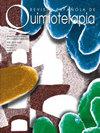Bacteremia caused by Clostridium sporogenes in an oncological patient.
IF 1.9
4区 医学
Q4 MICROBIOLOGY
引用次数: 1
Abstract
Rev Esp Quimioter 2023;36(2): 217-219 217 itive. The samples were subcultured on aerobic or anaerobic blood agar (BD Columbia Agar with 5% Sheep Blood, Becton Dickinson, Franklin Lakes, NY). All media were incubated at 37 oC. The AnaeroGen Compact anaerobic system (Oxoid Ltd, Wide Road, Basingstoke, England) was used. Gram staining of the blood cultures revealed abundant Gram-positive bacilli; on 24 hours of incubation, abundant colonies of these microorganisms were observed in pure culture on anaerobic blood agar alone. MALDI-TOF MS version 9 (8468 msp) (Bruker Biotyper, Billerica, MA) was employed, identifying the strain as C. sporogenes (score 2.35). The strain was sent to the Centre of Genomic and Oncologic Research (GENYO, Granada, Spain) for 16S rRNA gene sequence analysis using a previously reported method [4]. A fragment of 1,329 bp was obtained, yielding 99.85% similarity with the C. botulinum type strain Mfbjulcb5 GenBank sequence (accession number CP027776.1) and C. sporogenes strain CDC 1632 GenBank sequence (accession number CP013243.1). Subsequently, the sequence was compared using another database (IeBIBI IV 16s Automated ProKaryotes Phylogeny) confirming the strain as C. sporogenes. The 16S sequence was submitted to the GenBank (accession number: OP431824).肿瘤患者由产孢梭菌引起的菌血症。
本文章由计算机程序翻译,如有差异,请以英文原文为准。
求助全文
约1分钟内获得全文
求助全文
来源期刊
CiteScore
2.90
自引率
10.50%
发文量
146
审稿时长
>12 weeks
期刊介绍:
The official journal of the Sociedad Española de Quimioterapia (Spanish Society of Chemotherapy), publishes articles that further knowledge and advance the science and application of antimicrobial chemotherapy with antibiotics and antifungal, antiviral and antiprotozoal agents primarily in human medicine. Authors sign an exclusive license agreement, where authors have copyright but license exclusive rights in their article to the Publisher. All manuscripts are free open access. Revista Española de Quimioterapia includes the following sections: reviews, original articles, brierf reports, letters, and consensus documents.

 求助内容:
求助内容: 应助结果提醒方式:
应助结果提醒方式:


